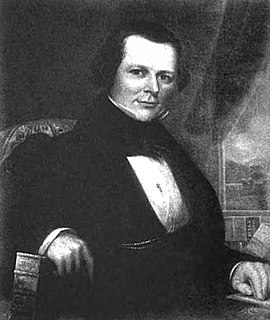 W
WWilliam Phipps Blake was an American geologist, mining consultant, and educator. Among his best known contributions include being the first college trained chemist to work full-time for a United States chemical manufacturer (1850), and serving as a geologist with the Pacific Railroad Survey of the Far West (1853–1856), where he observed and detailed a theory on erosion by wind-blown sand on the geologic formations of southern California, one of his many scientific contributions. He started several western mining enterprises that were premature, including a mining magazine in the 1850s and the first school of mines in the Far West in 1864.
 W
WArchibald Bruce was an American physician and mineralogist.
 W
WGeorge Jarvis Brush was an American mineralogist and academic administrator who spent most of his career at Yale University in the Sheffield Scientific School.
 W
WGeorge Washington Carpenter was an American scientist.
 W
WParker Cleaveland was an American geologist and mineralogist, born in Rowley, Massachusetts.
 W
WEdward Salisbury Dana was an American mineralogist and physicist. He made important contributions to the study of minerals, especially in the field of crystallography.
 W
WJames Dwight Dana FRS FRSE was an American geologist, mineralogist, volcanologist, and zoologist. He made pioneering studies of mountain-building, volcanic activity, and the origin and structure of continents and oceans around the world.
 W
WArthur Starr Eakle (1862–1931) was an American mineralogist. Eakle researched the mineralogical conditions of areas of California, Nevada and Hawaii. His work on Oahu, the third largest island in Hawaii, included identifying numerous new minerals.
 W
WWilliam Frederick Foshag was an American geologist and mineralogist. He published nearly 100 papers and described 13 new minerals, including foshagite.
 W
WSamuel Fowler was a doctor, state legislator, and member of the United States House of Representatives from northwestern New Jersey. As the owner of zinc and iron mines and an iron works at Franklin, New Jersey, he became a noted mineralogist who discovered several varieties of rare minerals.
 W
WFrederick Augustus Ludwig Karl Wilhelm Genth was a German-American chemist, specializing in analytical chemistry and mineralogy.
 W
WHenry Garber Hanks was an American mineralogist. He was the first state mineralogist of California.
 W
WRobert Miller Hazen is an American mineralogist and astrobiologist. He is a research scientist at the Carnegie Institution of Washington's Geophysical Laboratory and Clarence Robinson Professor of Earth Science at George Mason University, in the United States. Hazen is the Executive Director of the Deep Carbon Observatory.
 W
WGeorge Frederick Kunz was an American mineralogist and mineral collector.
 W
WHenry Carvill Lewis was an American geologist and mineralogist.
 W
WMarshall McDonald was an American engineer, geologist, mineralogist, pisciculturist, and fisheries scientist. McDonald served as the commissioner of the United States Commission of Fish and Fisheries from 1888 until his death in 1895. He is best known for his inventions of a number of fish hatching apparatuses and a fish ladder that enabled salmon and other migrating fish species to ascend the rapids of watercourses resulting in an increased spawning ground. McDonald's administration of the U.S. Commission of Fish and Fisheries was notably free of scandal and furthered the "protection and culture" of fish species throughout the United States.
 W
WJames Ferdinand Morton Jr. was an anarchist writer and political activist of the 1900s through the 1920s especially on the topics of the single tax system, racism, and advocacy for women. After about 1920 he was more known as a member of the Baháʼí Faith, a notable museum curator, an esperantist and a close friend of H. P. Lovecraft.
 W
WBenjamin Silliman was an early American chemist and science educator. He was one of the first American professors of science, at Yale College, the first person to distill petroleum in America, and a founder of the American Journal of Science, the oldest continuously published scientific journal in the United States.
 W
WGeorge Shirley Switzer was an American mineralogist who is credited with starting the Smithsonian Institution's famed National Gem and Mineral Collection by acquiring the Hope Diamond for the museum in 1958. Switzer made the arrangements when renowned New York City jeweler Harry Winston decided to donate the Hope Diamond to the Smithsonian.
 W
WGerardus Troost was a Dutch-American medical doctor, naturalist, mineralogist, and founding member and first president of the Philadelphia Academy of Natural Sciences.
 W
WMichael Tuomey was the State Geologist of South Carolina from 1844 to 1847, and the first State Geologist of Alabama, appointed in 1848 and serving until his death. His early descriptions and maps of the Birmingham District's unique coincidence of mineral resources for the making of steel opened the way for the early industrial development of the state.
 W
WOrville Frank Tuttle was an American mineralogist, geochemist, and petrologist, known for his research on granites and feldspars, with pioneering development of apparatus in experimental petrography.